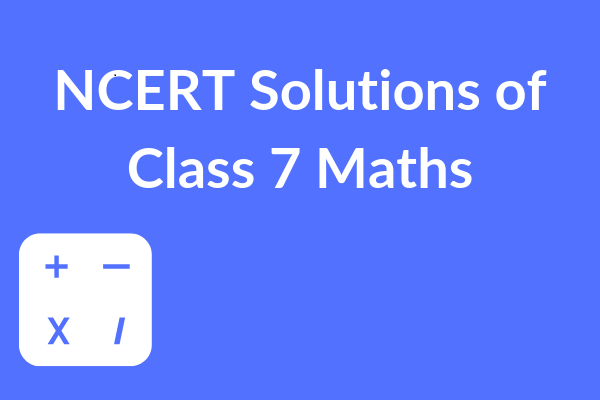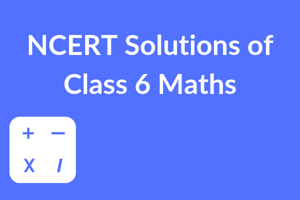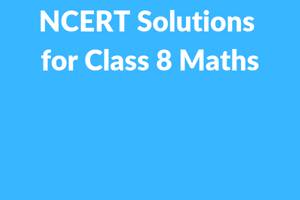Maths is an important subject that is applicable to several other academic courses. Class 6 maths...
7th Standard Maths CBSE Updated Chapters & Syllabus 2020-2021
Building a strong base in mathematics in the middle-school is very important for mathematics students. 7th standard maths holds crucial importance in shaping and developing the minds of the students for higher studies. Class 7 maths comprises some new topics that students are introduced for the very first time. These topics form the base for higher mathematical studies during high school as well as in professional courses.
Maths often seem to be a tricky and challenging subject to some students in the board exams. The main reason behind this is that students are not well familiar or very thorough with the junior and mid-school maths and foundation topics taught in middle school.

Class 7 maths hence hold prime importance in preparing students for even board exams. If a student gets well versed with all the chapters and topics included in the 7th class maths syllabus, and later classes, they will not find it difficult to crack the board exams.
The teachers and the subject matter experts at the CBSE have designed the 7th grade maths syllabus with utmost attention to multiple areas of mathematics. It includes geometry, algebra, integers, data handling, probability, angles, and so on.
We can say that the ncert 7th class book is a combination of all the mathematics topics studied till class 6 with further elaboration and some additional issues. If a student is thorough with his or her syllabus till grade 6, they will easily be able to understand and learn ‘class 7 maths’. Here we have a quick but detailed view of the class 7th maths syllabus.
Blog Contents
- 1 Chapter 1: Integers
- 2 Chapter 2: Fractions and Decimals
- 3 Chapter 3: Data handling
- 4 Chapter 4: Simple Equations
- 5 Chapter 5: Lines and Angles
- 6 Chapter 6: Triangles and its properties
- 7 Chapter 7: Congruence of Triangles
- 8 Chapter 8: Comparing Quantities
- 9 Chapter 9: Rational numbers
- 10 Chapter 10: Practical Geometry
- 11 Chapter 11: Perimeter and area
- 12 Chapter 12: Algebraic Expressions
- 13 Chapter 13: Exponents and power
- 14 Chapter 14: Symmetry
- 15 Chapter 15: Visualising Solid Shapes
Chapter 1: Integers
The first chapter in 7th standard maths is Integers. Students have studied this topic in the previous classes a hence, their understanding of the integers till class 6th will help them in analyzing and grasping this chapter better. Though being an essential part of maths books till class 6th, the integers chapter in class 7, maths introduces to some tricky concepts and topics. These are mentioned below:
- The first section of the chapter helps students recall the integers as studied in previous classes.
- Properties of Addition and Subtraction of Integers: in this section, there are many topics students are introduced to, such as additive identity, closure under subtraction, etc.
- Multiplication of Integers: As the name suggests, this section deals with various concepts and properties about the multiplication of different integers. The consecutive part is about the properties of multiplication.
- Division of Integers: As the name suggests, this section in ‘7th grade maths’ deals with various concepts and properties pertaining to the division of different integers. The consecutive section is about the properties of division.
Chapter 2: Fractions and Decimals
The second chapter in NCERT math book class 7 is about fractions and decimals. Just like the previous chapter integers, students have studied this topic in their previous classes. The extension of this topic in 7th standard maths introduces to some important topics, including:
- The first section of the chapter helps students recall the fractions as studied in previous classes.
- Multiplication of Fractions: As the name suggests, this section deals with various concepts and properties pertaining to the multiplication of different fractions.
- Division of Fractions: As the name suggests, this section in 7th grade maths deals with various concepts and properties pertaining to the division of different fractions.
- The next section of the 2nd chapter of the class ‘7th maths syllabus’ helps students recall the decimals as studied in the previous classes.
- Multiplication of Decimal Numbers: This section deals with various concepts and properties pertaining to the multiplication of different decimal numbers.
- Division of Decimal Numbers: This section deals with various concepts and properties pertaining to the division of different decimal numbers.
Chapter 3: Data handling
The Data Handling chapter in class 7th maths syllabus has some new and important topics like mean, median, and mode. The important topics covered in this chapter are as follows:
- Collecting Data
- Organisation Of Data
- Representative Values
- Arithmetic Mean
- Median
- Mode
- Use of Bar Graphs with A Different Purpose
- Chance and Probability
Chapter 4: Simple Equations
This chapter in 7th grade maths introduces students to different concepts in the simple equations in an entertaining and easy way. A lot of sections in this chapter are activity-based to help students learn practically and retain the knowledge forever. Like many other chapters, this forms an important foundation for later studies in mathematics. Students will have to apply the basic concepts and knowledge from this chapter in higher classes maths studies. The main sections in this chapter are:
- Setting Up of an Equation
- Recalling previous knowledge about equations
- A more detailed introduction to equations
- Solving equations
- From Solution to Equation
- Applications of Simple Equations to Practical Situations
Chapter 5: Lines and Angles
Geometry has been a fun, easy, and practical part of mathematics since the junior classes. The class 7 maths elaborates on this topic in multiple ways. This chapter in ‘7th standard maths’ focusses on lines and angles specifically from the geometry. The main topics covered are:
- Introduction to lines and angles and recalling previous knowledge
- Related Angles: This cover topics like Complementary Angles, Supplementary Angles, Adjacent Angles, Linear Pair, and Vertically Opposite Angles
- Pairs of Lines: This includes topics like Intersecting Lines, Transversal, Angles Made by A Transversal, and Transversal of Parallel Lines
- The next and the last section is about parallel lines and checking parallel lines.
Chapter 6: Triangles and its properties
As the name suggests, the next chapter in ‘NCERT math book class 7’ is about triangles and its different properties and concepts. This is one of the most critical topics in class 7 math question paper. This chapter includes the following main points:
- Introduction to triangles and some concepts
- Medians of a Triangle
- Altitudes of a Triangle
- Exterior Angle of a Triangle and Its Property
- Angle Sum Property of a Triangle
- Two Special Triangles: Equilateral and Isosceles
- Sum of The Lengths of Two Sides of a Triangle
- Right-Angled Triangles and Pythagoras Property
Chapter 7: Congruence of Triangles
This chapter elaborates more about triangles and some important concepts about it. Like the previous chapter, this also is an important topic in class 7 maths syllabus. The main points covered in this chapter are:
- Introduction to the congruence of triangles
- Congruence of Plane Figures
- Congruence Among Line Segments
- Congruence of Angles
- Congruence of Triangles
- Criteria for Congruence of Triangles
- Congruence Among Right-Angled Triangles
Chapter 8: Comparing Quantities
This chapter can be entirely new and tricky yet exciting to students entering class 7. This chapter in 7th standard maths introduces students to the percentage, buying, and selling, interests, etc., that will be useful for them in many different higher studies. This chapter includes:
- Equivalent Ratios
- Percentage – Another Way of Comparing Quantities: This introduces students to the Meaning of Percentage, Converting Fractional Numbers to Percentage, Converting Decimals to Percentage, etc.
- Use of Percentages
- Prices Related to An Item or Buying and Selling: This introduces students to the concept of profit and loss.
- Charge Given on Borrowed Money or Simple Interest
Chapter 9: Rational numbers
Like integers and fractions, this chapter in ‘class 7th maths’ is also an extension and elaboration on what students have studied in the earlier classes. However, it forms an important part of the class 7 math question paper. The topics covered here are:
- Introduction and recalling previous knowledge about rational numbers.
- Need for Rational Numbers
- What Are Rational Numbers?
- Positive and Negative Rational Numbers
- Rational Numbers on a Number Line
- Rational Numbers in Standard Form
- Comparison of Rational Numbers
- Rational Numbers Between Two Rational Numbers
- Operations on Rational Numbers
Chapter 10: Practical Geometry
Just like the previous chapter, this chapter in NCERT math book class 7 is also an extension and elaboration of previous topics studied in mathematics. This chapter covers some practical aspects of geometry that will be useful to students in higher classes. The topics covered in this chapter are:
- Construction of a Line Parallel To A Given Line, Through A Point Not On The Line
- Construction of Triangles
- Constructing A Triangle When the Lengths of Its Three Sides Are Known (SSS Criterion)
- Constructing A Triangle When the Lengths of Two Sides and The Measure of The Angle Between Them Are Known. (SAS Criterion)
- Constructing A Triangle When the Measures of Two of Its Angles and The Length of The Side Included Between Them Is Given. (ASA Criterion)
- Constructing A Right-Angled Triangle When the Length of One Leg and Its Hypotenuse Are Given (RHS Criterion).
Chapter 11: Perimeter and area
This chapter teaches students the important concepts in measuring the area and perimeter of different shapes. Students can learn this chapter in a very fun and easy way. This chapter can also include some activities to make it more interesting. The important points covered are:
- Squares and Rectangles
- Triangles as Parts of Rectangles
- Generalizing for Other Congruent Parts of Rectangles
- Area of a Parallelogram
- Area of Triangle
- Circumference of a Circle
- Area of Circle
- Conversion of Units
- Applications
Chapter 12: Algebraic Expressions
Algebra is an integral and important part of mathematics. In higher classes, algebraic equations are of keen importance in mathematics. This chapter in 7th grade maths forms a foundation for that. The important topics here are:
- How are Expressions Formed
- Terms of An Expression
- Like and Unlike Terms
- Monomials, Binomials, Trinomials, and Polynomials
- Addition and Subtraction of Algebraic Expressions
- Finding The Value of An Expression
- Using Algebraic Expressions – Formulas and Rules
Chapter 13: Exponents and power
Just like the previous chapter, this chapter in “class 7th maths” also forms an important foundation for mathematics in higher classes. It also helps students in building their logical and reasoning skills. Along with that, it makes them quite good at calculating big numbers and finding their squares and square roots. Here is a brief break-up of this chapter:
- Exponents
- Laws of Exponents
- Multiplying Powers With The Same Base
- Dividing Powers With The Same Base
- Taking Power of a Power
- Multiplying Powers With The Same Base
- Dividing Powers With The Same Exponents
- Miscellaneous Examples Using The Laws of Exponents
- Decimal Number System
- Expressing Large Numbers in The Standard Form
Chapter 14: Symmetry
This chapter is quite brief and short as compared to other chapters in NCERT math book class 7. Class 6th ncert syllabus also introduces students to the concept of symmetry but in a brief way. This chapter is an extension of that. The main points included here are:
- Lines of Symmetry for Regular Polygons
- Rotational Symmetry
- Line Symmetry and Rotational Symmetry
Chapter 15: Visualising Solid Shapes
The name of this chapter is quite self-explanatory. This chapter in “7th standard maths syllabus” helps students in identifying solids and their properties with different perspectives. The main topics here are:
- Introduction: Plane Figures and Solid Shapes
- Faces, Edges, and Vertices
- Nets for Building 3-D Shapes
- Drawing Solids on A Flat Surface
- Viewing Different Sections of a Solid
.png?width=100&height=100&name=Kapdec%20Logo%20(400px).png)


